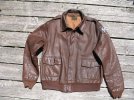blackrat2
Well-Known Member
So in light of some recent posts in the Vintage section, am I confusing myself in what original’s looked like when they came out of the factory
There has been lots of talk about pigment finishes and some great pics of Broncos where this finish is clear to see but they didn’t all come out like this surely?!
So was the original spec for pigment finish but that companies like Aero then branched off from this as contracts progressed through the war years
Why isn’t pigment being more readily made available by the current big makers??
I don’t currently have an original but I would appreciate any of you good folk posting up so we can see the variance in jackets
There has been lots of talk about pigment finishes and some great pics of Broncos where this finish is clear to see but they didn’t all come out like this surely?!
So was the original spec for pigment finish but that companies like Aero then branched off from this as contracts progressed through the war years
Why isn’t pigment being more readily made available by the current big makers??
I don’t currently have an original but I would appreciate any of you good folk posting up so we can see the variance in jackets



